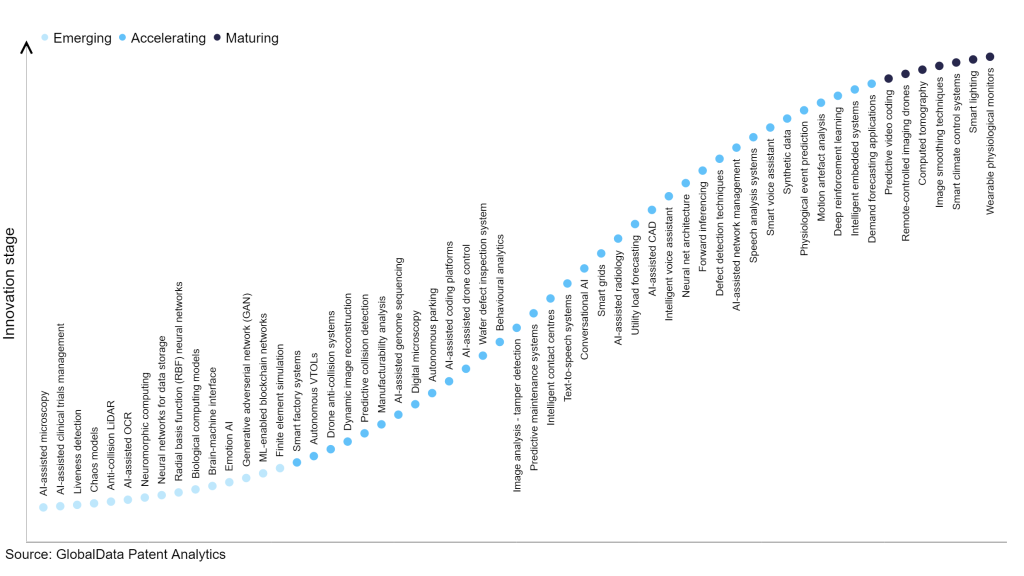The technology industry continues to be a hotbed of innovation, with activity driven by the rapid emergence and widespread adoption of game-changing technologies such as artificial intelligence (AI), Internet of Things (IoT), and robotics, and growing importance of technologies such as big data analytics, predictive analytics, data visualisation and machine learning. Demand forecasting applications are gaining immense importance in diverse industries due to the need for accurate demand predictions, increased data availability, advancements in machine learning algorithms, and the potential to optimise supply chain operations, inventory management, and decision-making processes. In the last three years alone, there have been over 3.6 million patents filed and granted in the technology industry, according to GlobalData’s report on Innovation in Artificial Intelligence: Demand forecasting applications. Buy the report here.
However, not all innovations are equal and nor do they follow a constant upward trend. Instead, their evolution takes the form of an S-shaped curve that reflects their typical lifecycle from early emergence to accelerating adoption, before finally stabilising and reaching maturity.
Identifying where a particular innovation is on this journey, especially those that are in the emerging and accelerating stages, is essential for understanding their current level of adoption and the likely future trajectory and impact they will have.
300+ innovations will shape the technology industry
According to GlobalData’s Technology Foresights, which plots the S-curve for the technology industry using innovation intensity models built on over 2.5 million patents, there are 300+ innovation areas that will shape the future of the industry.
Within the emerging innovation stage, finite element simulation, ML-enabled blockchain networks and generative adverserial network (GAN) are disruptive technologies that are in the early stages of application and should be tracked closely. Demand forecasting applications, intelligent embedded systems, and deep reinforcement learning are some of the accelerating innovation areas, where adoption has been steadily increasing. Among maturing innovation areas are wearable physiological monitors and smart lighting, which are now well established in the industry.
Innovation S-curve for artificial intelligence in the technology industry

Demand forecasting applications is a key innovation area in artificial intelligence
Demand forecasting applications encompass software programmes and systems designed to anticipate customer demand for products and services. These applications employ diverse data sources, statistical analysis, and algorithms to generate precise predictions. The objective of demand forecasting is to assist businesses in anticipating customer requirements and effectively strategising their operations.
GlobalData’s analysis also uncovers the companies at the forefront of each innovation area and assesses the potential reach and impact of their patenting activity across different applications and geographies. According to GlobalData, there are 310+ companies, spanning technology vendors, established technology companies, and up-and-coming start-ups engaged in the development and application of demand forecasting applications.
Key players in demand forecasting applications – a disruptive innovation in the technology industry
‘Application diversity’ measures the number of different applications identified for each relevant patent and broadly splits companies into either ‘niche’ or ‘diversified’ innovators.
‘Geographic reach’ refers to the number of different countries each relevant patent is registered in and reflects the breadth of geographic application intended, ranging from ‘global’ to ‘local’.
Patent volumes related to demand forecasting applications
Source: GlobalData Patent Analytics
IBM is a leading patent filer in demand forecasting applications. The company’s patents are related to methods, computer programme products, and systems providing a cognitive guide service to a group of participants for an excursion with an initial route planned by participants registration and environment information along the initial route. During the excursion, real time sensory data on the participants and change in environment are collected and relayed to a cognitive guide engine, and real time multi-objective optimisation is modelled and performed.
The participants are regrouped responsive to objectives of the excursion as represented by respective levels of interest in certain stage of the excursion as well as circumstances of the environment. Respective subgroups are formed from the participants per respective objectives, and respective new routes are selected from a set of optimal solutions for each subgroup. During the excursion, the cognitive guide engine iteratively optimises routes responsive to incoming real time sensory data and objectives of the excursion.
Other prominent patent filers in the space include Microsoft and Fanuc.
By geographic reach, Illumina leads the pack, followed by Turck duotec and ELMOS Semiconductor. In terms of application diversity, Amdocs holds the top position, followed by Talkdesk and Aptiv.
Demand forecasting applications enable businesses to make informed decisions, optimise resource allocation, and meet customer demands effectively. By providing accurate predictions, these applications help organisations streamline their operations, minimise risks, and enhance overall business performance.
To further understand how artificial intelligence is disrupting the technology industry, access GlobalData’s latest thematic research report on Artificial Intelligence (AI) – Thematic Intelligence.
Data Insights
From

The gold standard of business intelligence.
Blending expert knowledge with cutting-edge technology, GlobalData’s unrivalled proprietary data will enable you to decode what’s happening in your market. You can make better informed decisions and gain a future-proof advantage over your competitors.







